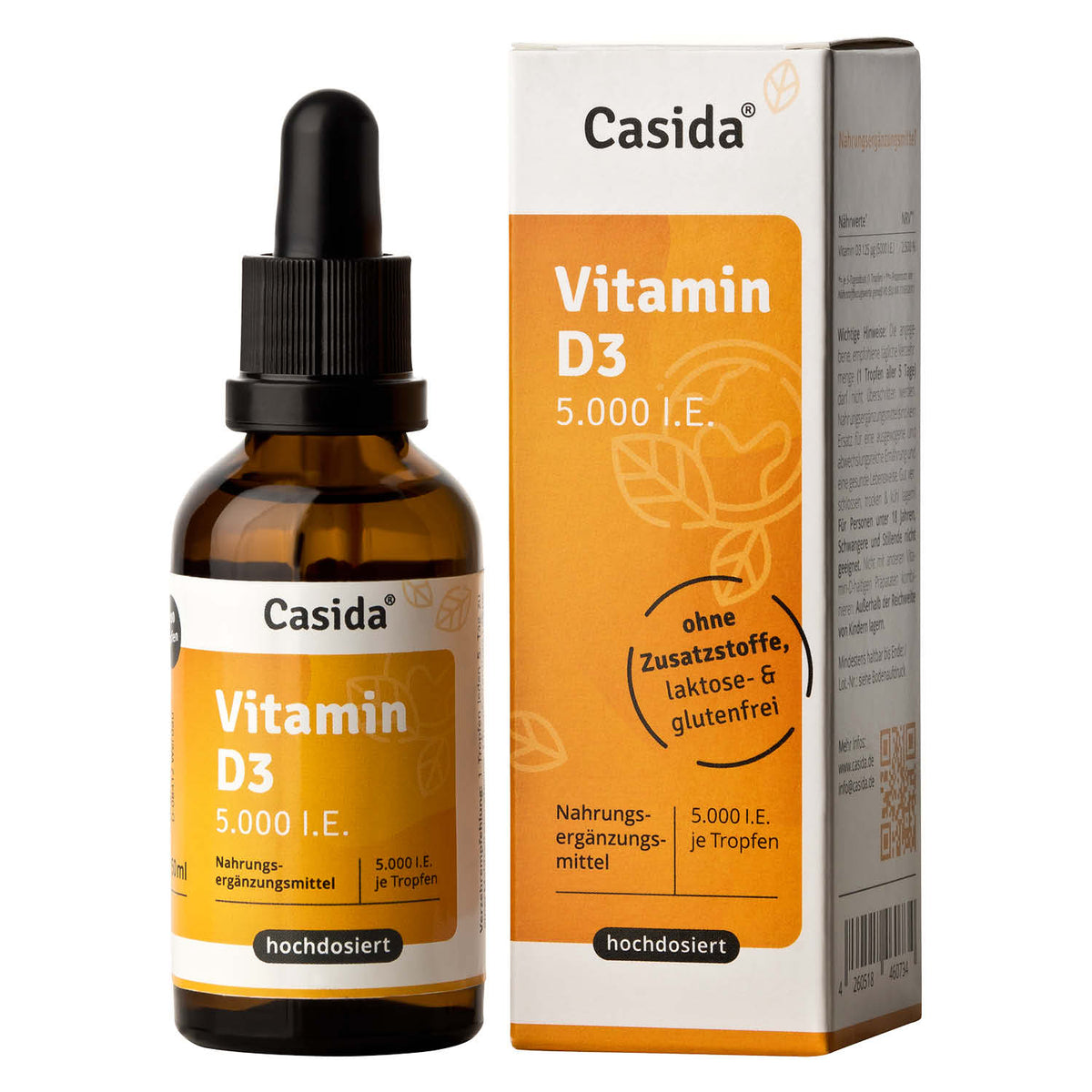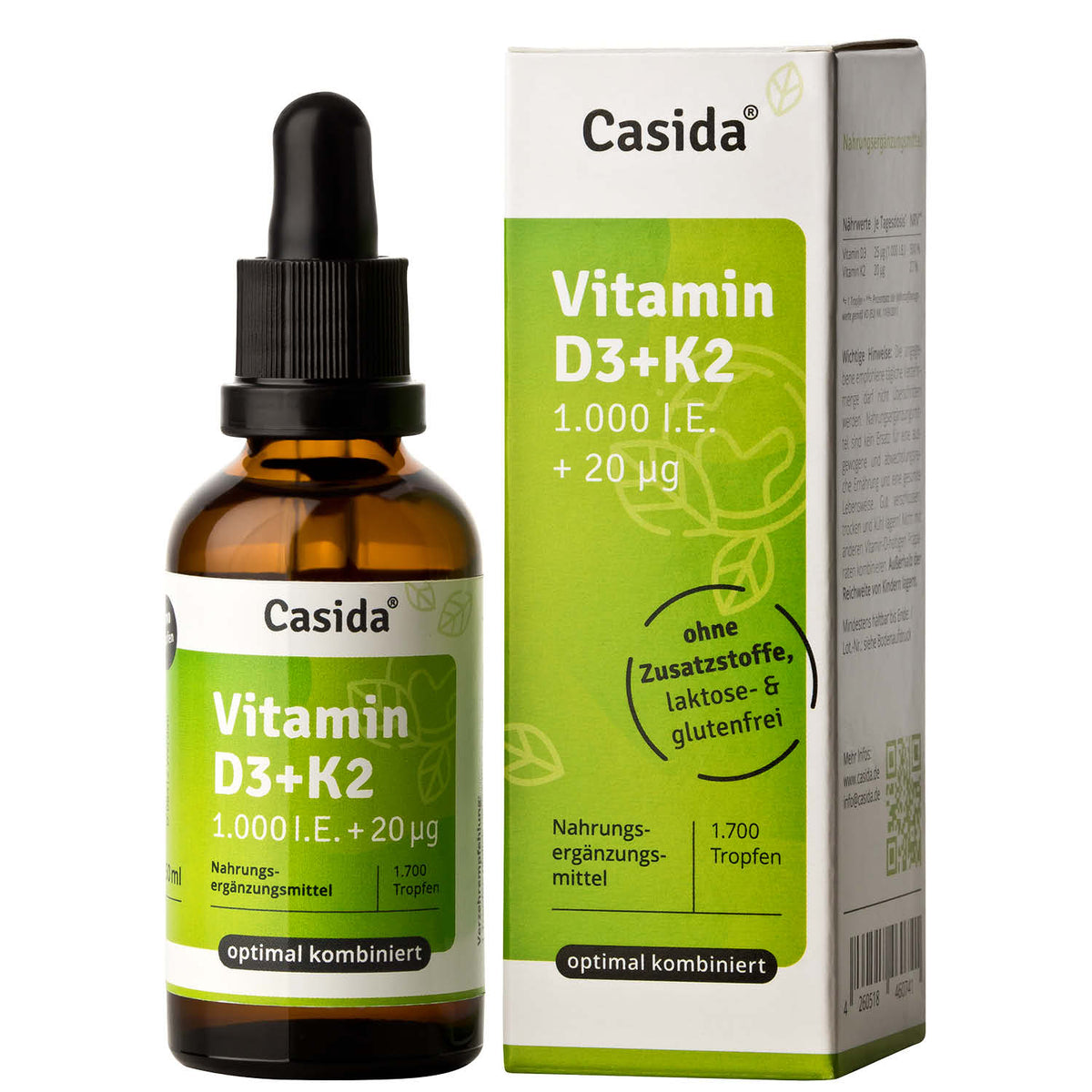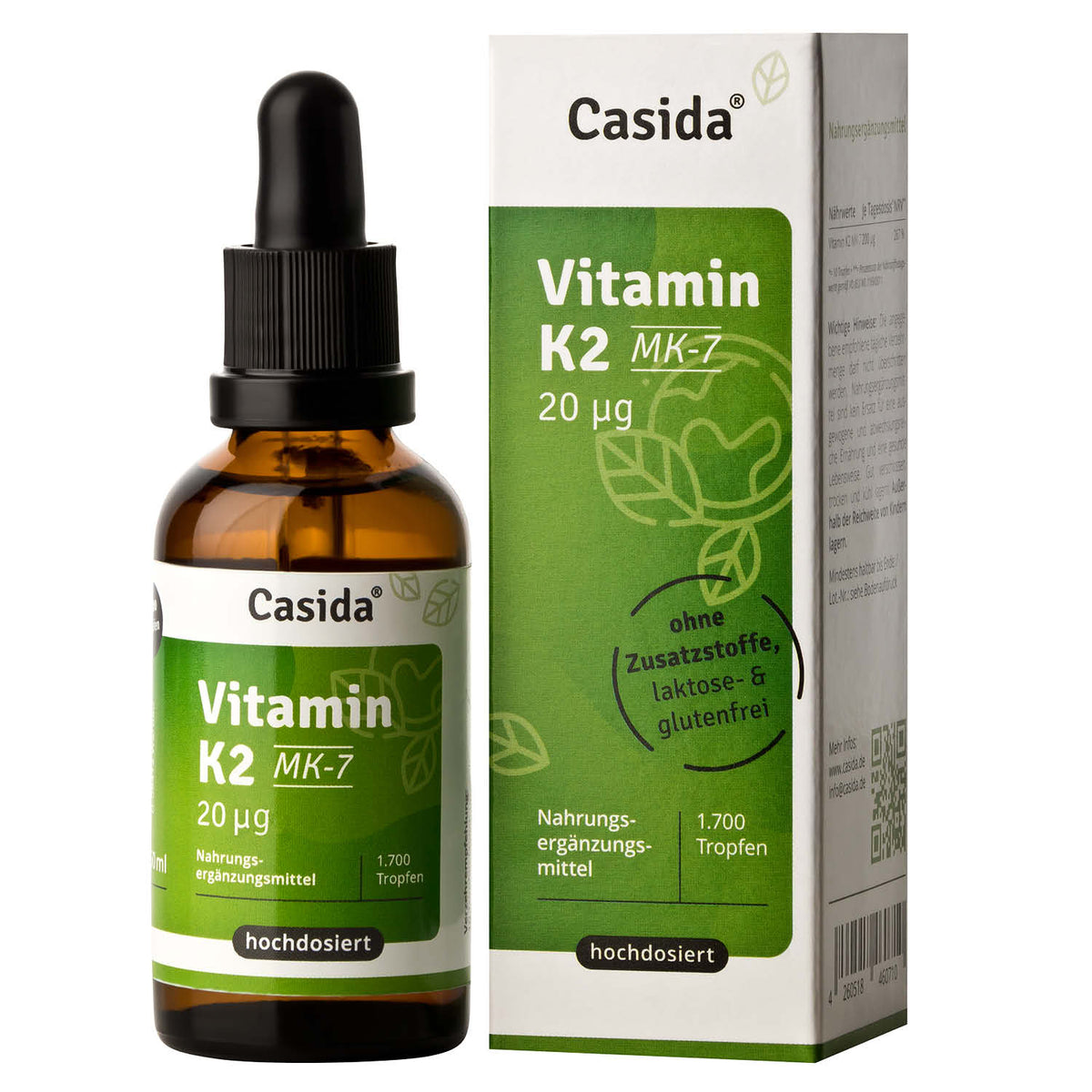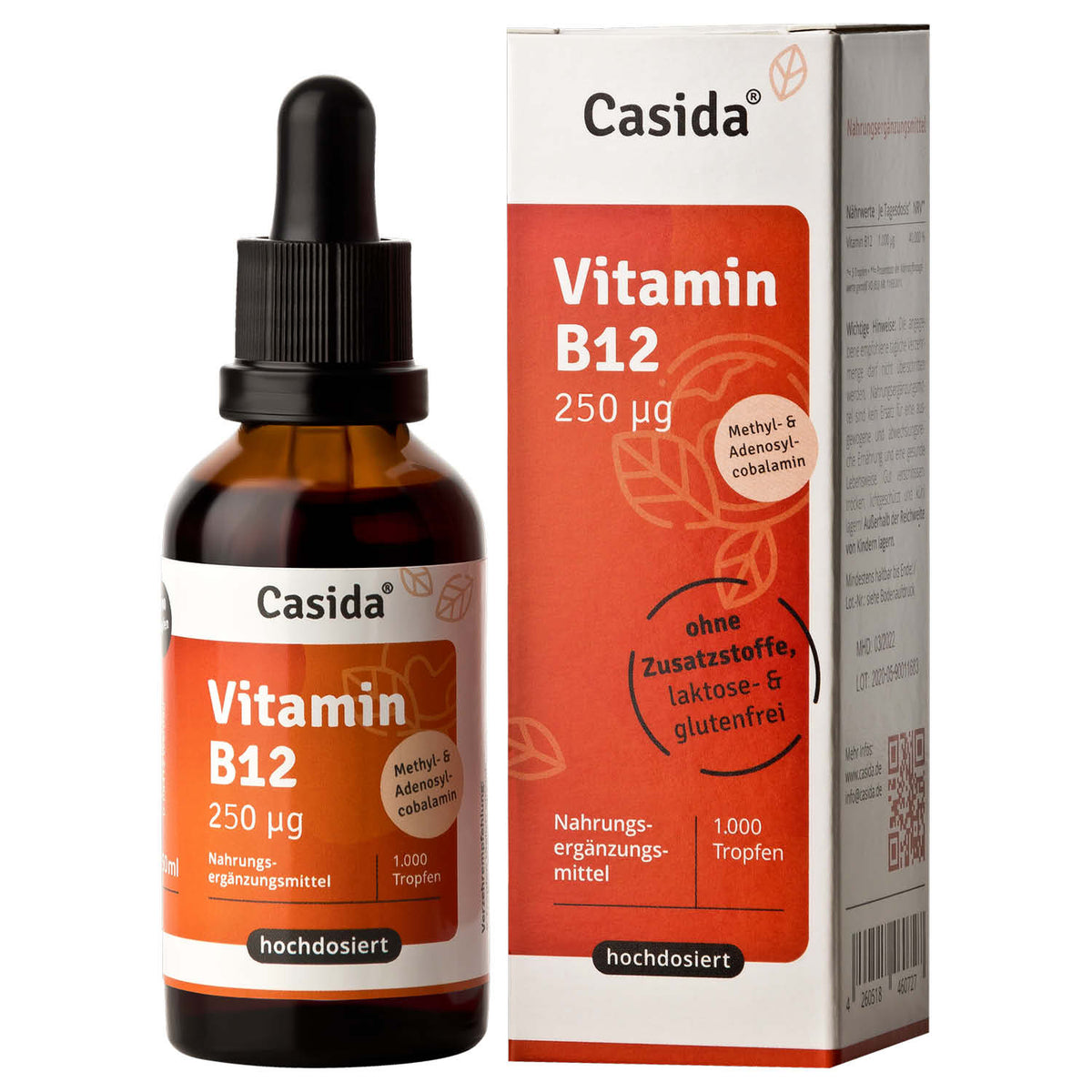Vitamin D is one of the most important vitamins for the human body. It supports the immune system and is a key component of numerous bodily processes. One of the most important sources of vitamin D is the sun, which is why it is also called the sunshine vitamin. Vitamin D is not only produced by sunlight, but is also found in certain foods. An unbalanced diet, a lack of UV radiation, and stress can therefore lead to vitamin D deficiency. But what are the other causes and symptoms that indicate a vitamin D deficiency? What should we look out for? What helps to alleviate symptoms? These and other important questions are thoroughly answered in the following text.
Table of Contents
What Effects Does Vitamin D Have?
Vitamin D in its current form is not actually produced by the body itself. However, since it is already present in the body as the inactive precursor 7-dehydrocholesterol, it does not belong to the group of vitamins. Only UV radiation activates it into its active substance. During the conversion, it becomes the hormone "calcitriol," which, among other things, supplies the body with calcium and modulates the immune system. A vitamin D deficiency can therefore negatively affect bones.
In addition to its effects on bones and the immune system, vitamin D also influences brain development and normal muscle function. A deficiency can therefore negatively impact the development of infants and embryos. Pregnant women should be especially careful to get enough vitamin D.
The so-called feel-good hormone, or serotonin, is also regulated by this vitamin. Thus, vitamin D can also indirectly influence mood.
What does vitamin D deficiency mean for bones?
Inadequate intake can have a very negative impact on bone health, because vitamin D ensures the absorption of calcium in the intestines and the storage of calcium in the bones. With a vitamin D deficiency, calcium is released from the bone substance, thus keeping the calcium level in the blood constant. However, this has a very negative impact on bone density and can lead to osteoporosis over time. The bones become more resilient and can break more quickly. It is assumed that vitamin D deficiency is responsible for a significant proportion of hip and femoral neck fractures.
Can vitamin D deficiency be the cause of respiratory infections?
Vitamin D deficiency has been proven to have negative effects on the immune system. Since an unstable immune system increases the risk of allergies, respiratory infections also occur more quickly. Vitamin D influences metabolism as well as the activity and functionality of defense cells.
How important is sunlight?
According to experts, it is not possible to supply the body with sufficient vitamin D through food alone. Food only covers up to 20% of the vitamin D requirement, while sunlight provides the remaining 80%. People who rarely go outside or who go out fully covered often suffer from vitamin D deficiency. Sunlight stimulates the production of the vitamin D precursor cholecalciferol, which is found in the skin. This is then converted into 25-OH vitamin D3 (calcidiol) and stored. The hormone calcitriol ensures, among other things, the absorption of calcium and phosphate from food and their incorporation into the bones.
Medical advice before taking supplements
It is important to consult a doctor before taking vitamin D supplements. Certain medications can increase or decrease the effect of vitamin D. These include, for example, cortisone, diuretics, sleeping pills, and antiepileptics. Caution is also advised in cases of kidney weakness, a tendency to form calcium-containing kidney stones, parathyroid disease, or sarcoidosis. Too much calcium in the blood, however, could have a negative impact on the unborn child. For this reason, pregnant women must be particularly careful and only take appropriate supplements under medical supervision if a vitamin D deficiency has been confirmed. This way, calcium levels can be kept under control.
Is it advisable to pay attention to foods containing vitamin D?
Many Germans suffer from vitamin D deficiency¹ because sunlight is too weak in the winter months and many people stay indoors even in the summer. This means the body has almost no chance of producing and storing vitamin D. The daily requirement can only be met up to 20% through diet, which is far from sufficient. Nevertheless, a vitamin D-rich diet is beneficial.
Although most foods contain small amounts of vitamin D, there are still vitamin D-rich foods, almost exclusively animal products. These include fatty fish such as herring and kippers, margarine and butter, milk, and eggs or egg yolks. Mushrooms and avocados also contain a form of vitamin D, although this is somewhat more difficult for the body to absorb.
However, a sandwich and two eggs are far from enough. The German Nutrition Society recommends a daily intake of 20 micrograms of vitamin D. To meet the recommended daily intake, one would need to consume, for example, 2400 grams of mushrooms, four kilograms of beef liver, four kilograms of butter, or 80 eggs. Consuming such amounts of these foods is unrealistic. Therefore, it is highly unlikely that vitamin D deficiency can be combated through diet. Without sunlight or appropriate vitamin D supplements, vitamin D needs cannot be met.
What are the causes of vitamin D deficiency?
In most cases, too little sunlight is the cause of vitamin D deficiency, while diet plays a rather minor role. Skin type, age, and the use of sunscreen also play a decisive role. However, according to a study from the USA, vitamin D deficiency is even partially prevalent in the summer. This means that some people struggle with a vitamin D deficiency despite sufficient sunlight.
There can be numerous reasons for this:
Sunlight One cause of vitamin D deficiency in the summer is certainly office work and generally working indoors. People who spend up to 8 hours or more indoors all day cannot take advantage of the sunlight at all. So, it doesn't matter what season it is. The sun in the evening after work is no longer as strong and is not enough to stimulate the body's production of the vitamin.
Another factor is long clothing. Short clothing is rarely worn at work, and thus UV rays are also lost on the way to and from work. Our arms and face are not enough for our bodies to produce sufficient vitamin D. Only by exposing most of the skin can vitamin D deficiency be counteracted.
Women, in particular, use numerous creams and lotions with UV protection because they want to prevent skin aging and protect themselves from sunburn. This is a good thing, as it minimizes the risk of skin cancer. However, such creams inhibit the body's production of vitamin D and act like long clothing. Since almost no UV radiation reaches the body, vitamin D production is almost as low as in the cold winter months. People who deliberately expose themselves to the sun for hours and use creams with UV protection can therefore also have a vitamin D deficiency. However, due to the risk of skin cancer, sunscreens and sunblocks cannot be completely avoided. The skin still gets at least some sun exposure.
Symptoms of Vitamin D Deficiency
The symptoms of a vitamin D deficiency are fairly nonspecific and could also indicate other diseases. These include:
- Fatigue
- Sleep disorders
- Muscle weakness
- Headaches
- Osteoporosis
- Bone fractures
- Hair loss
- Increased susceptibility to infections
- Impaired bone mineralization
- Bone pain
- Muscle cramps
- Neuromuscular hyperexcitability
According to the latest study results, the following diseases also occur with a lack of vitamin D intake on:
- High blood pressure
- Heart disease
- Diabetes
- Depression
- Tuberculosis
- Chronic kidney disease
- Cancer
- Asthma
- Metabolic diseases
- Multiple sclerosis
These serious illnesses can be linked to a vitamin D deficiency. Several studies have found a connection between vitamin D deficiency and diseases such as rheumatism, diabetes, or even cancer. More and more people are also suffering from so-called winter depression, which can be a symptom of low vitamin D levels in the blood. Researchers suspect that during the cold season, blood levels of the sunshine vitamin plummet, along with mood. Studies have shown that people between the ages of 20 and 50 who suffer from sleep disorders have lower vitamin D levels in their blood.
In addition to zinc and iron deficiencies, vitamin D deficiency is also said to affect the health of the hair roots. Vitamin D is said to promote growth receptors in the hair roots. Nevertheless, further research is needed to determine whether these diseases are symptoms of vitamin D deficiency or whether insufficient vitamin D intake is the cause. It is also still unclear whether an increased vitamin D intake could help combat such diseases.
Correcting the Symptoms of Vitamin D Deficiency
What to do if you have a vitamin D deficiency? Correcting the symptoms of a vitamin D deficiency is actually quite simple. Of course, it's important to know the cause of vitamin D deficiency.
Sun exposure In most cases, vitamin D deficiency is caused by insufficient sun exposure. The first step would be to go outdoors regularly and expose yourself to the sun's rays without protective clothing and sunscreen. The effectiveness of such therapy depends on the strength of the sun's rays. During the colder months and in the late afternoon, the sun's rays are not too strong and stimulate vitamin D production more slowly. This means that the time of year and day determine the length of sun exposure. Other important factors are age, skin type, and geographical latitude. However, caution is advised due to the increased risk of skin cancer. Staying in the sun too long without sunscreen could increase this risk. According to the German Nutrition Society, in Germany, 5 to 10 minutes of sunlight exposure are necessary between June and August for people with light to very light skin tones to stimulate adequate vitamin D production. Between March and May, as well as in September and October, 10 to 20 minutes are required for adequate vitamin D production. Darker skin types should stay in the sun for 15 to 25 minutes.
Are tanning beds a good substitute? Although artificial UV radiation contains UV-B rays, tanning beds are still unsuitable for treating vitamin D deficiency. While UV-B rays can stimulate vitamin D production, the skin is exposed to more UV-A radiation than sunlight. This exposes the skin not only to premature aging but also to an increased risk of skin cancer.
Eat foods rich in vitamin D Food can only cover a small amount of vitamin D. However, this is also a method for alleviating symptoms. Regular consumption of foods containing the sunshine vitamin can be useful as a supplement to treatment with sunlight and/or vitamin D supplements.
Vitamin D Supplements Especially in winter, supplementation with dietary supplements is recommended in Germany's latitudes due to low levels of sunlight. Adequate dietary intake is difficult to achieve in the long term. Vitamin D supplements are therefore useful when a vitamin D deficiency cannot be compensated for by food and sun exposure. Such supplements are also often used for medications that cause vitamin D deficiency. Your family doctor should decide whether and how these should be taken.
Vitamin D deficiency is initially corrected with a higher dose of vitamin D for one week. Once the level has been raised to the desired level, a low maintenance dose is used. After four weeks, vitamin D levels in the body should return to normal. A vitamin D test is usually used to monitor these levels. Many doctors recommend continuing the maintenance dose. If vitamin D deficiency persists, a new dosage is necessary.
But which vitamin D supplement is suitable? There is a wide range of supplements to choose from, which can vary greatly in terms of ingredients and dosage form. Bioavailability plays a crucial role. This determines the actual absorption and utilization of vitamin D in the body. Poor quality ingredients and the addition of additives could impair the effectiveness.
Vitamin D supplements are also available in various forms, such as drops or tablets. Since vitamin D is a fat-soluble vitamin, it is best absorbed by the body when enriched with oil. Always pay attention to the quality of the oil.
Combination of vitamin D and vitamin K2 It is usually recommended to take vitamin D together with vitamin K2. But why do vitamin D3 and vitamin K2 make such a good team? Taking high doses of vitamin D alone is always associated with certain health risks. Vitamin D increases the concentration of calcium in the blood, which is then utilized and deposited as harmful waste in the body. This can lead to calcification of blood vessels and organs, which can be dangerous.
But this is precisely where vitamin K2 comes in. The elevated calcium level in the blood is not the actual cause of the deposits, but rather the lack of vitamin K2. Vitamin K2 activates proteins that ensure the utilization of calcium in the blood. Since higher doses of the vitamin are common in cases of vitamin D deficiency, these two vitamins should always be taken together. Corresponding preparations are available on the market.








